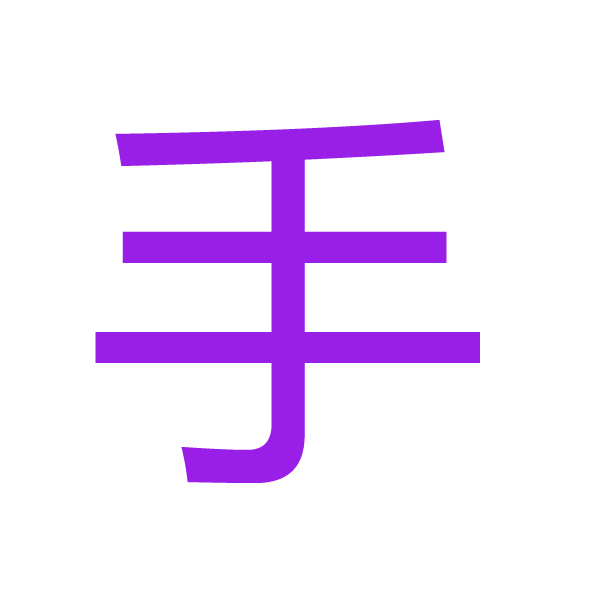
The Kanji: 手 (Te) - The "Hand" Kanji
The kanji 手 is one of the most fundamental characters in Japanese, directly representing the human hand. It serves as a radical for many other kanji related to actions and skills.
1. Meaning and Usage
Core Meanings: Hand; method; way of doing; skill.
Readings:
Kun'yomi (Japanese reading): て (te), た (ta-)
On'yomi (Chinese reading): シュ (shu)
Common Words and Compounds:
手 (て / te) - Hand.
手紙 (てがみ / tegami) - Letter (Literally "hand paper").
歌手 (かしゅ / kashu) - Singer (Literally "song hand" → person with singing skill).
下手 (へた / heta) - Unskillful (Literally "lower hand").
運転手 (うんてんしゅ / untenshu) - Driver.
2. Writing and Stroke Order: Capturing the Form of a Hand
The correct kanji writing for "手" is essential. Its stroke order is logical and helps in writing the character fluidly and correctly.
Stroke Order:
Stroke 1: A short horizontal stroke from left to right. This represents the thumb or the base of the fingers.
Stroke 2: A longer horizontal stroke, parallel and just below the first one. This represents the main line of the fingers.
Stroke 3: A long vertical stroke that starts above the top horizontal, cuts through both horizontals, and curves slightly at the end. This is the arm and the main structure of the hand.
Stroke 4: A final horizontal折 (or) stroke. Start with a short horizontal line attached to the vertical, then turn downward into a hook. This represents the remaining finger or the wrist.
Significance of Correct Kanji Writing:
Proportions: The two top horizontal strokes should be closer together, with the vertical stroke extending significantly below them. This creates the distinctive "hand and arm" silhouette.
Fluid Motion: The stroke order, particularly the long vertical stroke (3) followed by the final hook (4), allows for a natural, continuous writing motion that results in a well-balanced character.
Radical Recognition: As the "hand" radical (手偏, tehen), it often appears in a simplified form (扌) on the left side of characters, indicating actions performed by hand (e.g., 持つ - to hold, 投げる - to throw).
3. Historical Origin and Evolution
The history of "手" is a clear journey from a detailed pictogram to a stylized symbol.
Oracle Bone Script (甲骨文字):
The earliest form was a highly detailed pictogram of a hand with five fingers outstretched. It clearly showed the palm and the five digits, often with the thumb distinctly separated from the other four fingers.
Bronze Script (金文) & Seal Script (篆書):
Over time, the character became more stylized. The five fingers were simplified, but the overall shape of an outstretched hand remained clearly visible. The lines became thicker and more uniform, moving away from a direct drawing towards a symbolic character.
Modern Form (楷書):
The modern "手" is a complete abstraction. The five fingers have been simplified into the two top horizontal strokes and the final hook. The long vertical stroke represents the arm and the central structure of the hand. While it no longer looks like a detailed drawing, the essence of the hand's form—a horizontal part (the fingers) attached to a vertical part (the arm)—is perfectly preserved.
Cultural and Linguistic Connection:
In Japanese culture, the hand ("te") is synonymous with skill, action, and personal ability. This is reflected in many compound words:
上手 (じょうず / jōzu) - Skillful (Literally "upper hand").
手配 (てはい / tehai) - Arrangements (Literally "hand arrangement").
The character embodies the idea that the hand is the primary tool for human action and creation.
Summary
The kanji 手 is a perfect example of how a concrete object evolved into an elegant written symbol. Mastering its stroke order is a fundamental step in Japanese kanji writing, as it teaches balance and a common structural pattern. Understanding its history—from a five-fingered pictogram to the modern abstract form—enriches the process of learning kanji, connecting your practice to the ancient visual language of human experience. When you write "手," you are not just drawing a character; you are tracing the form of the very tool that shapes our world.